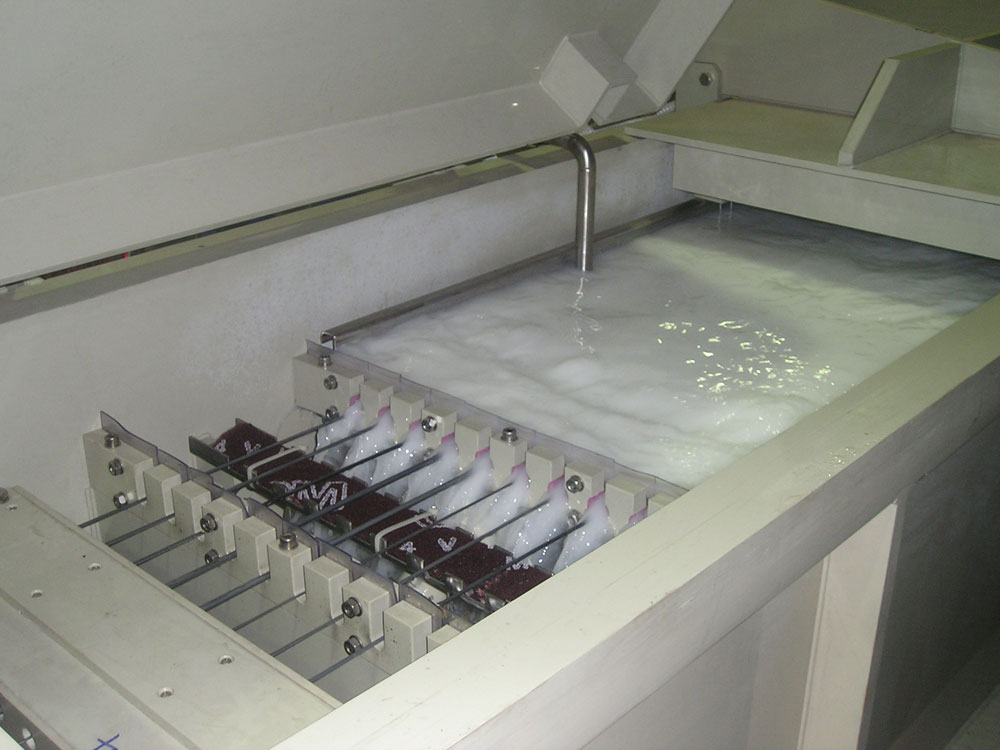EQUIPMENTS
Ultrasonic and electrolytic cleaning
Requests for cleaning processes in the wire industry continuously increase along with higher quality requirements. Cleaning consists in removing any contaminant agent present on the surface of a wire albeit not chemically linked to it.
Cleaning is used for stainless steel, low and high carbon steel, aluminium alloy, and copper wires to remove calcium and sodium stearate lubricant residues after the dry drawing process, or lubricant oil from a wet drawing machine or forming process, etc.

Two types of technologies are usually used for this purpose: ultrasonic cleaning and electrolytic cleaning. Both have their advantages but must be chosen very carefully according to the type of wire and the sort of product that must be removed from the wire. Let's briefly compare the two technologies.
Ultrasonic cleaning uses high frequency sound waves, resulting in cavitation, where micro-size bubbles form, grow and implode due to alternating positive and negative pressure waves. A tremendous amount of energy is stored inside the bubble just before it implodes. In the event that the implosion should occur near a hard surface, the bubble changes into a jet that travels at a speed of approximately 400km/h towards the hard surface. Because of the inherent small size of the jet, ultrasonic cleaning has the ability to reach into small crevices, thus removing entrapped soils very effectively.
The basic components of an ultrasonic cleaning system include some ultrasonic transducers, an electrical generator and a tank containing the cleaning solution.
The ultrasonic generator converts a standard electrical frequency of 50 or 60 Hz into the high frequencies required. The higher the frequency, the smaller the bubbles created during the cavitation will be.
The transducers are constituted of PZT elements (Pb-Zr-Ti) that convert the electrical energy into mechanical vibrations by piezoelectric action. The transducers are installed inside a stainless steel watertight box immersed in the cleaning bath and situated a few centimetres below the wire field. A watertight cable connects the transducer holding box to the generator.
The cleaning solutions used in the ultrasonic cleaning lines must cautiously be selected and take into consideration the type of wire and application. Generally speaking, for the great majority of applications in the wire industry, alkaline solutions are favoured to remove oily matter while phosphoric acid-based solutions are preferred to remove stearate soaps.
The working temperature has a profound effect on the effectiveness of ultrasonic cleaning. Usually, higher temperatures result in higher cavitation intensity and better cleaning. However, should the solution temperature get to close to the boiling point of the solution, the liquid will boil in the negative pressure areas of the sound waves, thus reducing or eliminating the cavitation effect. We usually work around 60°C (140°F), which offers an excellent compromise.

In the electrolytic method, the wire passes through an electrolyte in a processing zone divided into different chambers. Electrodes are located in each chamber and adjacent electrodes are connected to opposite poles of a direct current supply source. Electrical current constantly passes between the electrodes in the adjacent chambers through the electrolyte and the wire as the latter travels through the chambers in the processing zone. This way, the wire is alternately polarized negatively and positively as it travels through processing zones. The migration of ions of the electrolyte resulting from polarization will allow some chemical reactions to take place quickly at the surface of the wire, such as the formation of hydrogen or oxygen bubbles. The thus-created bubbles at the surface of the wire will remove the dirt present on the wire by a mechanical effect.
The chemical solution used for electrolytic cleaning is not very different from that used in the ultrasonic process. Electrolytic cleaning is used in the majority of the applications based on phosphoric acid or alkaline solution. Some additives may be used to increase the conductivity of the solutions.
Temperature is also a key parameter. As electrolytic process generates very high heat in the bath, the latter must generally be cooled. Conductivity of the solution is increased by the temperature but cannot be too near to the solution’s boiling point since the creation of bubbles reduces conductivity. The working temperature range usually oscillates between 40°C (104°F) and 60°C (140°F).

Very often, the electrolytic process is more aggressive than ultrasonic cleaning with a risk of acid solutions dissolving the iron surface content of the wire. In the specific case of cleaning stainless steel wire before annealing, it has been demonstrated that a combined system using first a short electrolytic cleaning followed with an ultrasonic cleaning produces the best results as it utilizes the advantages of both systems.
For construction materials, Sirio Wire recommends that the tanks should be made of polypropylene with one reservoir and one overflow bath to avoid any inflexion of the wire. One vertical pump transfers the solution from the reservoir to the overflow bath. To avoid any down time, we suggest that a standby pump should be installed.
After the cleaning operation, it is essential to thoroughly rinse the wire to remove any chemical residual. Sirio Wire has developed a special system working with pressurized water that allows the best rinsing effect.
All Sirio Wire equipment is fitted with a special mechanical drop trap and very effective air wiping devices to limit the liquid drag out to an absolute minimum.
